When one thinks about algae-eating fish, guppies may not come to mind straight away. However, guppies are known to eat some types of algae, making them potentially useful as part of a tank cleaning and maintenance routine.
In this article, we’ll explore whether guppies eat algae, and the different types of algae they are likely to consume.
Can Guppies Eat Algae? And Do They?
Yes, guppies can and do eat algae. They are omnivores, meaning they consume both plant and animal matter for sustenance. If you’ve ever seen a guppy nibbling on aquatic plant leaves, you may have noticed it also chews on algae growing on these leaves. It is also not uncommon for guppies to dive into the substrate in search of bits of plant matter they can chow down on.
Learning that your pet guppy is an algae eater is good news for any fish tank owner. Not only does this mean you can rest easy knowing that your guppy is eating a balanced diet, but it also means they may help to keep your guppy tank free of excessive algae. Any fishkeeper who has ever tried to combat the growth of algae will agree that a few extra mouths don’t hurt!
Of course, this doesn’t mean you can get rid of your algae scraper and expect your guppy to do all the work. You’ll still need to manage algae growth by keeping your tank water clean, and ensuring that your aquarium light cycles are appropriate for your tank inhabitants. The oxygen levels in your tank should also be maintained, as guppies need oxygen-rich water to stay healthy.
Types of Algae Guppies Can Eat
Having established that guppies can eat algae, the next question is: what types of algae are guppies likely to consume? Generally speaking, guppies are happy to consume a wide range of algae, though they may show a preference for certain types. Here are a few kinds of algae you may find your guppies nibbling on:
Staghorn Algae
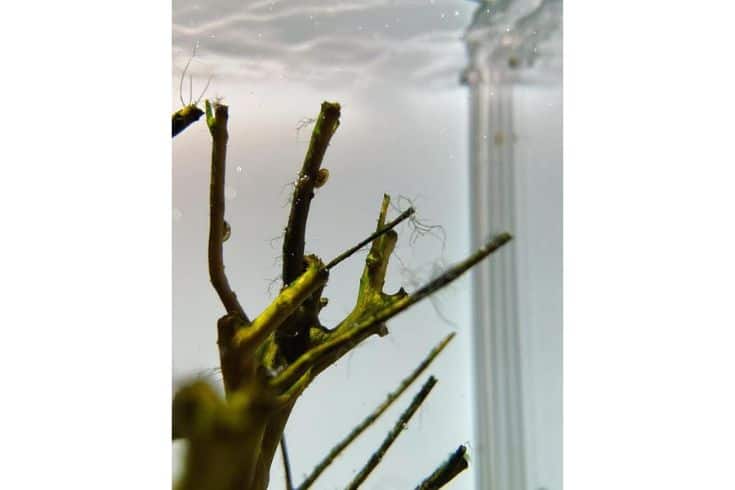
Named after its antler-like growths, staghorn alga is a common sight in aquariums. This type of algae is usually found growing on driftwood, rocks, and aquarium plants. They are a fairly common sight in guppy fish tanks, particularly those with low carbon dioxide levels. Staghorn algae are also commonly found in tanks with poor water circulation.
Because of its ubiquity, it’s no surprise that this type of algae is a favorite among guppies. Staghorn algae are not only rich in nutrients, but their antler-like shape makes them the perfect snack for a guppy’s small mouth. You will likely find your little guppies snacking on these algae growths, particularly when they are newly formed.
Black Beard Algae
Black beard algae are also known as brush algae, and it’s easy to see why. This type of algae looks like fine strands of hair, and can often look brown or black in color. It’s usually found growing on driftwood, rocks, and aquarium plants, which makes it another easy target for guppies.
Black beard algae are also rich in nutrients, so it’s no wonder that guppies like to snack on them. However, this type of algae is usually the most difficult to get rid of, so you may want to monitor your tank carefully if your guppies are eating a lot of it.
Green Hair Algae
As one might’ve surmised based on its name, green hair algae or thread algae resemble strands of fine green hair – so much so that they are sometimes mistaken for fuzz algae. The difference, of course, is that the former is long, individual strands, while the latter has a more cottony appearance. Think of green hair algae as more of a ‘wild grass’ growing in your aquarium.
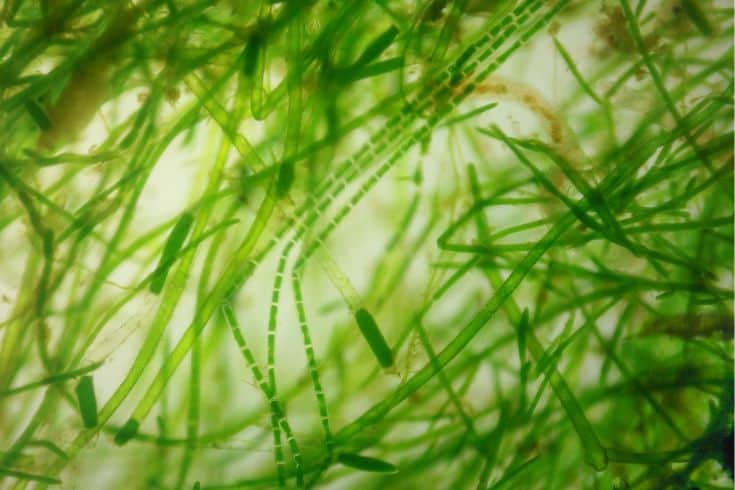
Guppies are particularly drawn to green hair algae due in part to its soft texture and easy-to-chew nature. The nutritional content of this type of algae can also be an attractive factor, as it is a great source of vitamins and minerals.
Brown Algae
Guppies will also eat brown algae, a type of algae that is also known as ‘diatoms’. Diatoms are single-celled organisms and can form a thin film on surfaces such as rocks and glass. Brown algae usually have a golden or yellowish-brown appearance, and can sometimes look like fine dust.
Because brown algae are suspended in water rather than attached to surfaces, guppies can find it particularly easy to access and eat. Brown algae are also a good source of nutrition, making them great for a well-rounded diet.
Green Water Algae
When people think of algae blooms, they usually think of green water algae. This alga is the bane of many aquarists’ existence, as it can take over a tank in just a few days. All it takes is some exposure to intense lighting (accidental or intentional), and the green water alga can start to bloom.
Frustrating as green water algae may be, there is some good news: guppies love to eat it. Though your tiny, three-inch friends won’t be able to rid your tank of the algae entirely, they can certainly lend a helping hand. Green water algae are also relatively nutritious, so it’s good for your guppies.
Blue-Green Algae
Blue-green algae, aka. Aquatic cyanobacterium is a type of algae that can appear in the form of slimy mats on the surface of your aquarium. Though it’s not as common as other algae, it can still be a nuisance.
Fortunately, guppies seem to love eating blue-green algae. Not only does it provide a good source of vitamins and minerals, but its slimy texture makes it especially appealing to guppies.
As you can see, guppies are happy to consume most types of algae. However, these fish are omnivorous, so their diet is not limited solely to algae. The next section deals with some of the other types of foods guppies eat.
What Else Do Guppies Eat? A General List
Guppies can derive a lot of nutrients from algae, but these omnivorous fish require a variety of food sources to stay healthy. Supplementing their diet with protein and commercially produced fish food can go a long way in ensuring that your guppies get the vitamins and minerals they need. Here’s a detailed list of what you should feed your guppies:
Pellet Foods/ Fish Flakes
As far as food types go, commercially-produced fish food is probably the most popular way to feed guppies. Pellet and flake foods are easy-to-find, widely available, and shelf-stable, making them great as a primary food source for both guppies and larger fish alike.
Most hobbyists opt for a tropical fish formula that contains a good mix of amino acids, vitamins, and minerals. These form the cornerstone of a balanced diet and can help keep your fish healthy and active. Some brands also use color-enhancing ingredients to bring out the natural hues of your guppies.
It’s important to look for a high-quality product with a variety of ingredients. Many budget-friendly foods are made with mostly fillers and low-quality ingredients, so look for a product with multiple sources of proteins, fats, and carbs. We’ve curated a list of our favorite guppy foods for your little friends, but we encourage you to do your own research and find something that meets your specific needs.
Live Foods
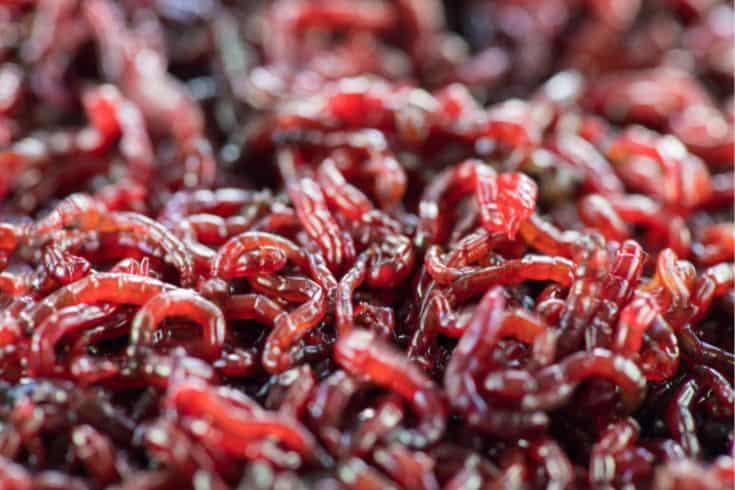
For the truly adventurous guppy keeper, live foods are the way to go. Live foods provide the most nutrition for your guppies, with live bloodworms, brine shrimp, and daphnia being some of the most popular choices. These protein-rich food sources cost a pretty penny, but for many discerning fishkeepers, their nutritional benefits are well worth the price.
Although live foods are nutritionally dense, they can also introduce parasites and diseases so caution should be taken. We recommend sourcing your live foods from a reputable source – preferably one that’s located locally. This allows you to pay a visit to the shop, check out their tanks, and ask questions. It also helps to ensure the food is kept in good condition and free from parasites.
Another factor to keep in mind is that live foods have an incredibly short shelf life. They can quickly spoil if not refrigerated or frozen, so they should be consumed as soon as possible. You can opt to raise your own live food cultures at home, but this requires a bit more effort and a bit more money. However, this can make a fun challenge for the more dedicated fish keepers.
Vegetables
Most people don’t think of vegetables when they think of fish food, but they can be an important part of a guppy’s diet. Vegetables such as zucchini, spinach, kale, and lettuce can provide essential vitamins, minerals, and fiber.
Some guppies may even enjoy the occasional treat of cooked peas or carrots. Vegetables should be offered in moderation, and should always be blanched or cooked before serving. This helps to make them more palatable and easier to digest.
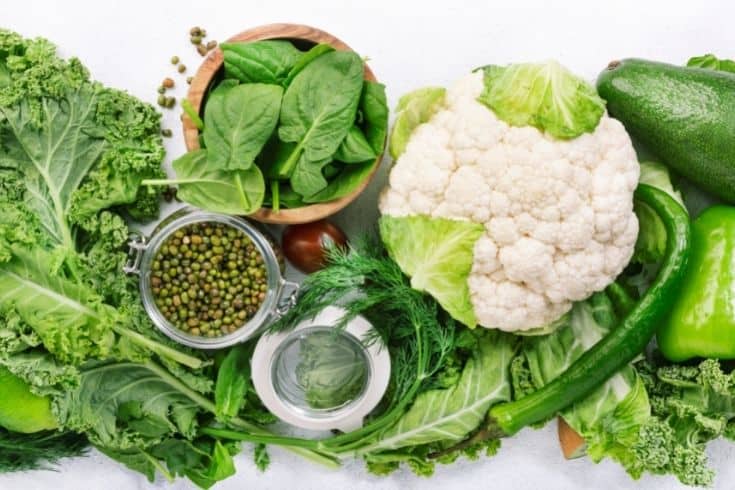
We recommend offering a variety of vegetables to your guppies, but avoid those that are high in oxalates (spinach, kale, swiss chard, etc.). These can interfere with calcium absorption, so feed them sparingly.
Algae Wafers
We’ve already discussed the different types of algae that can benefit your guppy, and now we’ll discuss how to feed them in the form of a wafer. Algae wafers are a great way to give your guppies a nutritious snack that they’ll love. The wafers are made from a blend of natural algae, vitamins, and minerals, and are typically high in protein and low in fat.
Algae wafers are typically used as a supplemental food source – only if your guppies don’t get enough plant matter from other sources. They should be offered sparingly, as they can quickly lead to overfeeding if used too frequently. Remember that a balanced diet is key to healthy guppies, so make sure to feed them a variety of foods to keep them healthy and active.
Guppy Treats
Insects, freeze-dried worms, and other treats can be a great addition to any guppy’s diet. These treats should be offered sparingly, however, as too many can lead to nutritional imbalances. Small invertebrates such as daphnia and brine shrimp are great for providing extra protein, while freeze-dried bloodworms can help to satisfy the occasional craving.
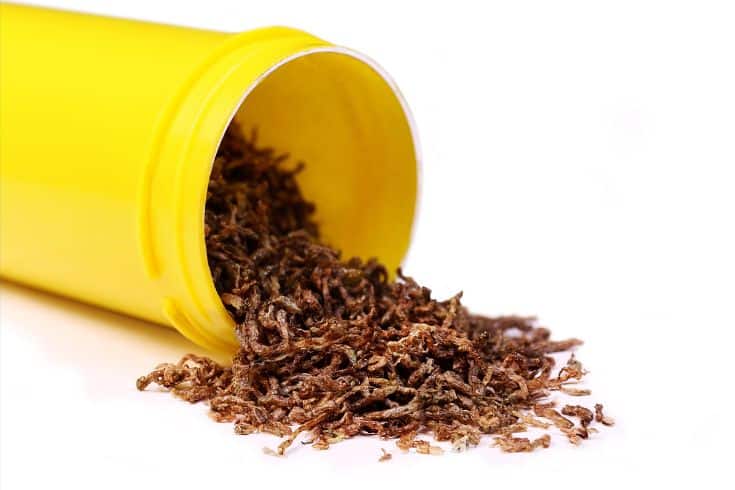
Treats should not be used as a replacement for a balanced diet, but rather as a special once-in-a-while treat. Make sure to track how much your guppies are eating, and adjust the portion size accordingly. Remember that guppies may not always eat their treats right away, so you’ll want to keep an eye on them to ensure they’re not overeating.
The Takeaway
So yes – guppies do eat algae. Not only is it a natural source of nutrients, but it’s also a great way to keep your tank clean and free of harmful bacteria. However, this doesn’t mean that your guppies will be content to survive for weeks eating just algae. The best way to keep your fish healthy and active is to develop a balanced diet that incorporates a variety of foods.
We hope you found this article helpful! Remember to take good care of your guppies, and please share this article with someone who might find it useful!
